| |
FLOWERPECKERS Dicaeidae |
- 48 species in Asia, Australasia, and western Pacific
- DR personal total: 31 species (64%), 12 photo'd
|
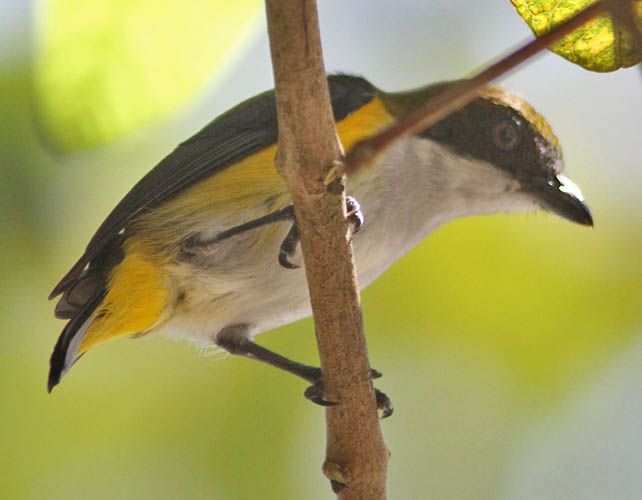 The Dicaeidae is a largish family composed of all the flowerpeckers in genus Dicaeum (42 species) and Prionochilus
(6 species). Flowerpeckers range throughout tropical forests from India
to Australasia and the Solomon Islands, but they reach their peak of
diversity in southeast Asia, the Greater Sundas, and the Philippines.
This striking and big-billed flowerpecker (left) is Yellow-sided Flowerpecker,
endemic to Sulawesi, Indonesia. It has been observed to use its bill to
squeeze out seeds of large fruit before swallowing them. The Dicaeidae is a largish family composed of all the flowerpeckers in genus Dicaeum (42 species) and Prionochilus
(6 species). Flowerpeckers range throughout tropical forests from India
to Australasia and the Solomon Islands, but they reach their peak of
diversity in southeast Asia, the Greater Sundas, and the Philippines.
This striking and big-billed flowerpecker (left) is Yellow-sided Flowerpecker,
endemic to Sulawesi, Indonesia. It has been observed to use its bill to
squeeze out seeds of large fruit before swallowing them.
Flowerpeckers
eat a wide variety of fruits, berries, nectar and insects, but "all
members of the Dicaeidae probably have an association with mistletoes,
since all of them have a modified intestinal tract adapted to deal with
mistletoe berries... Seeds that are swallowed pass through the
digestive tract unharmed;" (Cheke & Mann 2008). |
 Quite
by coincidence, three of the species shown on this page are holding
what might be a mistletoe seed. I don't know much about plants, but
Cheke & Mann (2008) state that more than 21 species of mistletoe in
a dozen genera have been recorded as food sources for flowerpeckers. Quite
by coincidence, three of the species shown on this page are holding
what might be a mistletoe seed. I don't know much about plants, but
Cheke & Mann (2008) state that more than 21 species of mistletoe in
a dozen genera have been recorded as food sources for flowerpeckers.
This colorfully stripe-breasted flowerpecker (right) is Yellow-breasted Flowerpecker,
a widespread species that occurs on the Malayan Peninsula, and on
Sumatra and Borneo. It is one of six species in genus Prionochilus. All
members of this genus have a rather long outer primary; a short, deep,
broad bill; and a four-pronged tip to the tongue (Cheke & Mann
2008). The latter point helps to feed on nectar.
The Mistletoebird
(below) is the lone flowerpecker on mainland Australia. Its habitat is
described as "almost anywhere mistletoes are found" in a wide variety
of woodlands. I think we can be sure this adult male is devouring a
mistletoe seed; we can see others hanging from the vine on the branch
it is perched. |
|
|
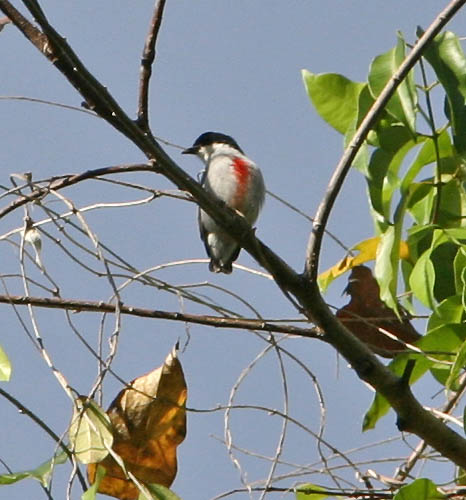 Fledgling flowerpeckers can be dull and inconspicuous, presumably as a protection from predators. A fledging Mistletoebird
(above left) is very unlike the colorfully-patterned adult male (as
shown above), but females of this species are also dull in appearance.
In some flowerpeckers, adults of both sexes are plain. Indeed, there is
even a bird called Plain Flowerpecker Dicaeum concolor. Buzzing Flowerpecker of the Philippines (above right) is also quite unassuming, so it is named for its vocalizations. Fledgling flowerpeckers can be dull and inconspicuous, presumably as a protection from predators. A fledging Mistletoebird
(above left) is very unlike the colorfully-patterned adult male (as
shown above), but females of this species are also dull in appearance.
In some flowerpeckers, adults of both sexes are plain. Indeed, there is
even a bird called Plain Flowerpecker Dicaeum concolor. Buzzing Flowerpecker of the Philippines (above right) is also quite unassuming, so it is named for its vocalizations.
In contrast, many Dicaeum flowerpeckers have striking combinations of colors, often including black, white, and red. The Red-keeled Flowerpecker (right), endemic to the west Visayan Islands of the Philippines, is a fine example. Blood-breasted Flowerpecker
(below) of Java and nearby islands is very striking with its black
head, upperparts and belly contrasting with a blood-red breast and
tawny-orange flanks.
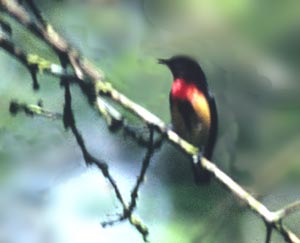
|
 Both sexes of Yellow-vented Flowerpecker
(left) are similar; it looks like this one may be visiting another type
of mistletoe. It ranges widely from the Himalayan foothills of
northeast India to Borneo and Java. It has a somewhat larger and more
curved bill that most flowerpeckers, permitting it to feed on insects
and larger fruit, like figs, as well as mistletoe. Both sexes of Yellow-vented Flowerpecker
(left) are similar; it looks like this one may be visiting another type
of mistletoe. It ranges widely from the Himalayan foothills of
northeast India to Borneo and Java. It has a somewhat larger and more
curved bill that most flowerpeckers, permitting it to feed on insects
and larger fruit, like figs, as well as mistletoe.
There
are so many species of flowerpeckers that one must do a lot of
island-hopping to observe a wide spectrum of this family. Although all
flowerpeckers are more or less similar in size — quite small,
short-tailed, arboreal birds — their striking variations in color
patterns makes them very attractive. This multi-colored male (below, in
a nice shot by Blake Matheson) is Palawan Flowerpecker, endemic to the island for which it is named. The female is a dingy olive-gray with a yellow rump and washed yellowish below. |
|
Bulletin 21 of the Oriental Bird Club featured a painting of a male Cebu Flowerpecker Dicaeum quadricolor
on the cover (below) and an article on forest loss in Cebu,
Philippines, inside (Brooks et al. 2005). The Cebu Flowerpecker was
rare by 1906 on its namesake island and thought to be extinct by the
1950s. It was rediscovered in a tiny patch of remnant forest at
Tiburan, Cebu, in 1992. It remains "critically endangered."
Blake Matheson and I were among a small Tim
Fisher-led group that spent a day in a multi-level tree platform at
Tiburan in Dec 2005. We were very fortunate to have quick views of a
male (Blake) and a female (me) over our six hours of survey effort
there.
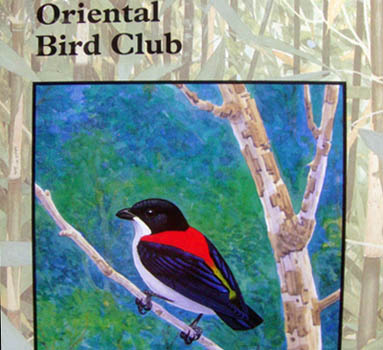
|
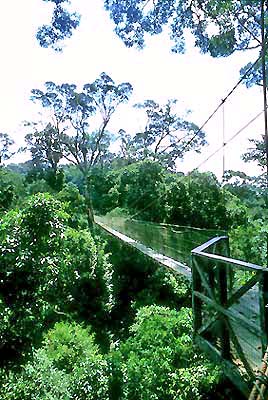
Another
great story is the discovery of an as-yet unnamed flowerpecker
photographed from the canopy walkway at Borneo Rainforest Lodge in
Danum Valley, Sabah, Borneo in June 2009 [photo of that walkway, above,
from 2003]. Photos of the "Spectacled Flowerpecker" feeding on
flowering mistletoe high in the canopy, taken by Richard Webster, were
published by Edwards et al. (2009). It is may be a canopy specialist
but there is, at yet, no specimen and no formal scientific description.
There is, obviously, still much to learn about flowerpeckers.
|
|
| |
Photos: The Yellow-sided Flowerpecker Dicaeum crepitans was in the Sedoa Valley, Sulawesi, Indonesia, on 26 Sep 2011. The Yellow-breasted Flowerpecker Prionochilus maculatus was in the Panti Forest, Malaysia, on 24 Sep 2011. Both the adult male and the fledgling Mistletoebird Dicaeum hirundinaceum were in Serpentine Gorge, West MacDonnell NP, Australia, on 16 Aug 2008. The Buzzing Flowerpecker D. hypoleucum was near Bislig, Mindanao, Philippines, in Jan 2006. The Red-keeled Flowerpecker D. haematostictum was on Mt. Canloan, Negros, Philippines, in Dec 2005. The Blood-breasted Flowerpecker D. sanguinolentum was in Gede NP, Java, Indonesia, in Aug 1988. The Yellow-vented Flowerpecker D. chrysorrheum was in Khao Yai NP, Thailand, on 25 Dec 2012. Blake Matheson photographed the Palawan Flowerpecker Prionochilus plateni along 'Zigzag Road' in southern Palawan, Philippines, in Dec 2005. The cover art of Cebu Flowerpecker Dicaeum quadricolor
is by Richard Allen, and the photo of the Danum Valley canopy walkway
was taken in Aug 2003 (six years before "Spectacled Flowerpecker" was
discovered here).
Uncredited photos © Don Roberson. Credited photos © Blake Matheson, as credited, and used with permission; all rights reserved.
Family book:
Robert A. Cheke, Clive F. Mann, and Richard Allen. 2001. 
Sunbirds: a Guide to the Sunbirds, Flowerpeckers, Spiderhunters, and Sugarbirds of the World. Christopher Helm, London.
This
is a very nicely done "family book" — actually, a three-family book —
in the Helm Identification Series. In standard format, the first half
of the book is color plates with facing text on plumage characters and
i.d. points, plus a good showing of subspecific variation. The second
half is the main text with range maps, detailed descriptions, full
discussion of subspecies, habitat, food, and breeding biology. All
these topics are given in short summary fashion, but provide a fine
overview. This book was an important first step to sorting out sunbird
phylogeny, although it was before most of the molecular studies and was
thus based primarily on plumage, structure, and (in some cases)
vocalizations. Overall the paintings are crisp, clear, and useful, and
the text a good summary on many topics.
Literature cited:
Brooks,
T., P. Magsalay, G. Dutson, and R. Allen. 1995. Forest loss,
extinctions and last hope for birds on Cebu. OBC Bulletin 21: 24–27.
Cheke,
R.A., C.F. Mann, and R. Allen. 2001. Sunbirds: a Guide to the Sunbirds,
Flowerpeckers, Spiderhunters, and Sugarbirds of the World. Helm
Identification Guide. C. Helm, London.
Cheke, R.A. and C.F. Mann. 2008. Family Dicaeidae (Flowerpeckers), pp. 350–388 in
Handbook of the Birds of the World (del Hoyo, J., A. Elliott & D.A.
Christie, eds). Vol. 13. Lynx Edicions, Barcelona, Spain.
Edwards,
D.P., R.E. Webster, and R.A. Rowlett. 2990. "Spectacled Flowerpecker":
a species new to science discovered in Borneo? Birding Asia 12: 38–41.
|
|
|

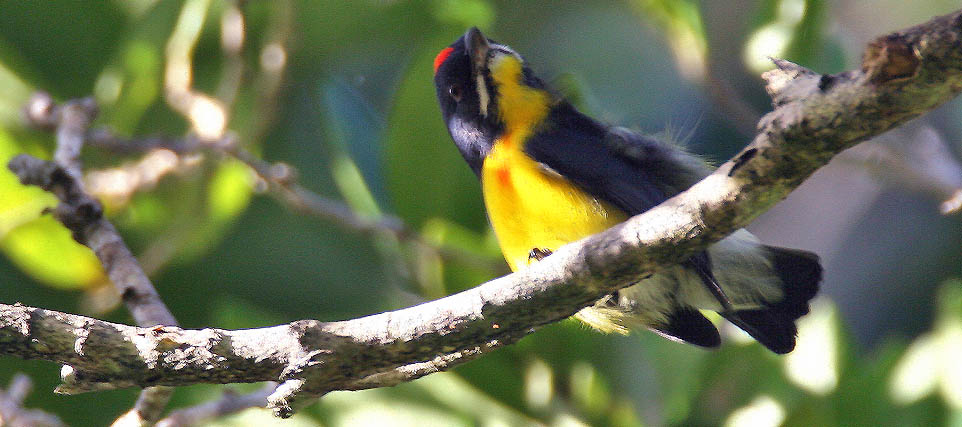
 The Dicaeidae is a largish family composed of all the flowerpeckers in genus Dicaeum (42 species) and Prionochilus
(6 species). Flowerpeckers range throughout tropical forests from India
to Australasia and the Solomon Islands, but they reach their peak of
diversity in southeast Asia, the Greater Sundas, and the Philippines.
This striking and big-billed flowerpecker (left) is Yellow-sided Flowerpecker,
endemic to Sulawesi, Indonesia. It has been observed to use its bill to
squeeze out seeds of large fruit before swallowing them.
The Dicaeidae is a largish family composed of all the flowerpeckers in genus Dicaeum (42 species) and Prionochilus
(6 species). Flowerpeckers range throughout tropical forests from India
to Australasia and the Solomon Islands, but they reach their peak of
diversity in southeast Asia, the Greater Sundas, and the Philippines.
This striking and big-billed flowerpecker (left) is Yellow-sided Flowerpecker,
endemic to Sulawesi, Indonesia. It has been observed to use its bill to
squeeze out seeds of large fruit before swallowing them.  Quite
by coincidence, three of the species shown on this page are holding
what might be a mistletoe seed. I don't know much about plants, but
Cheke & Mann (2008) state that more than 21 species of mistletoe in
a dozen genera have been recorded as food sources for flowerpeckers.
Quite
by coincidence, three of the species shown on this page are holding
what might be a mistletoe seed. I don't know much about plants, but
Cheke & Mann (2008) state that more than 21 species of mistletoe in
a dozen genera have been recorded as food sources for flowerpeckers. 
 Both sexes of Yellow-vented Flowerpecker
(left) are similar; it looks like this one may be visiting another type
of mistletoe. It ranges widely from the Himalayan foothills of
northeast India to Borneo and Java. It has a somewhat larger and more
curved bill that most flowerpeckers, permitting it to feed on insects
and larger fruit, like figs, as well as mistletoe.
Both sexes of Yellow-vented Flowerpecker
(left) are similar; it looks like this one may be visiting another type
of mistletoe. It ranges widely from the Himalayan foothills of
northeast India to Borneo and Java. It has a somewhat larger and more
curved bill that most flowerpeckers, permitting it to feed on insects
and larger fruit, like figs, as well as mistletoe. 

